Degradation Assessment of Natural Stone Claddings over Their Service Life: Comparison between Tehran (Iran) and Lisbon (Portugal)
Abstract
:1. Introduction
2. Materials and Methods
2.1. Climatic and Environmental Exposure Conditions
2.2. Data Acquisition and Limitations of the Method Proposed
3. Description of the Samples Analysed
- (i).
- Aesthetic degradation, which has a visual impact on the cladding, not jeopardising its integrity; these anomalies can be observed in most stone claddings and tend to occur prematurely;
- (ii).
- Joint defects, which affect the proper functioning of the joints of the cladding and can promote the occurrence of new anomalies;
- (iii).
- Fastening to the substrate that jeopardises the claddings’ and the users’ safety;
- (iv).
- Loss of integrity due to the modification of the physicochemical properties of the stone (e.g., due to the exposure to pollutants), leading to irreversible changes in the physical and aesthetic properties of the claddings.
4. Service Life Prediction Model
5. Analysis of the Degradation Evolution According to Claddings’ Characteristics
6. Results and Discussion
- -
- Tehran, the capital of Iran, is one of the most densely populated cities in the world, with a population around 12 million, and is located in an active seismic zone [55]; for that reason, the structures in Iran are designed for an optimal service life of around 30 years, after which some actions must be carried out to reduce the vulnerability of the buildings to the seismic action [56,57]. In this sense, the Tehran sample presents more recent buildings (with lower ages) than the Lisbon sample (in which the design service life is usually 50 years). According to the proposed model, the natural stone claddings reach the end of their service life after 65 years in Tehran and after 68 years in Lisbon. These values agree with the literature: (i) Silva et al. [2] adopted different statistical models for the service life prediction of stone claddings, and an estimated service life ranging between 68 and 90 years was obtained; (ii) Shohet and Paciuk [41], considering a lower level of users’ demand, attained an estimated service life of 64 years (with a range of 59 to 70 years);
- -
- The results obtained for both samples are coherent, and similar degradation patterns were identified in both samples; i.e., stone claddings in more unfavourable conditions reach the end of their service life sooner than claddings more protected from the deterioration agents. The only exception is for the façades’ orientation, although for both samples, the north and west orientations have lower service lives due to high exposure to damp and prevailing winds;
- -
- Pitzurra et al. [58] suggest that atmospheric agents and air pollution are the major causes for the degradation of external stone claddings, while other authors [55,59] suggest that the extent of degradation of the stone claddings is influenced by the type of stone used and its mineralogical composition, as well as by its physical and mechanical properties. The results in Table 4 reveal that the type of stone is the most influential parameter in the service life of natural stone claddings in Lisbon. On the other hand, exposure to prevailing winds and application of the cladding in bottom walls, which are more protected from the environmental agents, seem to be the most relevant factors for the deterioration of stone claddings in Tehran (these characteristics have the highest impact on the loss or gain of the estimated service life of stone claddings in Tehran);
- -
- The results seem to reveal that two different atmospheric agents have a significant impact on the deterioration of stone claddings in the two geographical contexts. In Lisbon, the exposure to damp seems to be a relevant factor, which is accountable by the north orientation; this sample is located in different areas of the city, some closer to the river and the ocean, others more protected, which allows the verification of the impact of this action on the service life of stone claddings. On the other hand, in the Tehran sample, all the claddings are in the same district, thus presenting the same exposure to this action. However, driven rain proved to be a very important degradation agent, mainly because there are also high levels of atmospheric pollution associated with this action. The presence of pollutants was shown to be unquestionably relevant in the Tehran sample, with a higher incidence of anomalies caused by this action, such as the loss of integrity defects (e.g., erosion of stone), discoloration of stone elements and deposition of debris and superficial dirt.
7. Concluding Remarks
Author Contributions
Funding
Institutional Review Board Statement
Informed Consent Statement
Data Availability Statement
Acknowledgments
Conflicts of Interest
References
- Wekesa, B.; Steyn, G.; Otieno, F. The response of common building construction technologies to the urban poor and their environment. Build. Environ. 2010, 45, 2327–2335. [Google Scholar] [CrossRef]
- Silva, A.; De Brito, J.; Gaspar, P.L. Service life and durability of assemblies. In Methodologies for Service Life Prediction of Buildings; Springer: Berlin/Heidelberg, Germany, 2016; pp. 13–66. [Google Scholar]
- Haagenrud, S. Factors causing degradation. In Guide and Bibliography to Service Life and Durability Research for Buildings and Components; CIB Working Commission W080/RILEM Technical Committee 140-TSL: Ottawa, ON, Canada, 2004; p. 108. [Google Scholar]
- Chai, C.; De Brito, J.; Gaspar, P.; Silva, A. Predicting the service life of exterior wall painting: Techno-economic analysis of alternative maintenance strategies. J. Constr. Eng. Manag. 2013, 140, 04013057. [Google Scholar] [CrossRef]
- Daniotti, B.; Spagnolo, S. Service life prediction tools for buildings’ design and management. In Proceedings of the 11th International Conference on Durability of Building Materials and Components (11th DBMC), Istanbul, Turkey, 11–14 May 2008. [Google Scholar]
- Pearce, D.W. The social and economic value of construction. In The Construction Industry’s Contribution to Sustainable Development, NCRISP; Davis Langdon Consultancy: London, UK, 2003. [Google Scholar]
- Brand, S. How Buildings Learn: What Happens after They’re Built? 1st ed.; Phoenix Illustrated: London, UK, 1997. [Google Scholar]
- Slaughter, E.S. Design strategies to increase building flexibility. Build. Res. Inf. 2001, 29, 208–217. [Google Scholar] [CrossRef]
- Gaspar, P.L. Service Life of Constructions: Development of a Methodology to Estimate the Durability of Construction Elements, Application to Renders in Current Buildings. Ph.D. Thesis, Instituto Superior Técnico, Technical University of Lisbon, Lisbon, Portugal, 2009. (In Portuguese). [Google Scholar]
- Neto, N.; De Brito, J. Inspection and defect diagnosis system for natural stone cladding. J. Mater. Civ. Eng. 2011, 23, 1433–1443. [Google Scholar] [CrossRef]
- Watt, D.S. Building Pathology: Principles and Practice, 2nd ed.; Blackwell Science Ltd., Blackwell Publishing Company: London, UK, 2007. [Google Scholar]
- Rivard, H.; Bédard, C.; Fazio, P.; Ha, K.H. Functional analysis of the preliminary building envelope design process. Build. Environ. 1995, 30, 391–401. [Google Scholar] [CrossRef]
- Yılmaz, N.G.; Goktan, R.M.; Kibici, Y. Relations between some quantitative petrographic characteristics and mechanical strength properties of granitic building stones. Int. J. Rock Mech. Min. Sci. 2011, 48, 506–513. [Google Scholar] [CrossRef]
- Gaspar, P.L.; De Brito, J. Quantifying environmental effects on cement-rendered facades: A comparison between different degradation indicators. Build. Environ. 2008, 43, 1818–1828. [Google Scholar] [CrossRef]
- Norvaišienė, R.; Miniotaitė, R.; Stankevičius, V. Climatic and air pollution effects on building facades. Mater. Sci. 2003, 9, 102–105. [Google Scholar]
- Frohnsdorff, G.; Martin, J. Towards prediction of building service life: The standards imperative. In Proceedings of the 7th Durability of Building Materials and Components (7th DBMC), Stockholm, Sweden, 19–23 May 1996. [Google Scholar]
- Kus, H.; Carlsson, T. Microstructural investigations of naturally and artificially weathered autoclaved aerated concrete. Cem. Concr. Res. 2003, 33, 1423–1432. [Google Scholar] [CrossRef]
- Searls, C.L.; Thomasen, S.E. Repair of the terra-cotta facade of Atlanta City Hall. In Proceedings of the 2nd International Conference on Structural Repair and Maintenance of Historical Buildings, Seville, Spain, 14–16 May 1991. [Google Scholar]
- Henriksen, J.F. Reactions of gases on calcareous stones under dry conditions in field and laboratory studies. Water Air Soil Pollut. 1995, 85, 2707–2712. [Google Scholar] [CrossRef]
- Shohet, I.; Rosenfeld, Y.; Puterman, M.; Gilboa, E. Deterioration patterns for maintenance management—A methodological approach. In Proceedings of the 8th International Conference on Durability of Building Materials and Components, Vancouver, BC, Canada, 30 May–3 June 1999. [Google Scholar]
- Cohen, L.; Manion, L.; Morrison, K. Ex post facto research. In Research Methods in Education, 6th ed.; Taylor & Francis Group: Oxfordshire, UK, 2007; pp. 267–271. [Google Scholar]
- Silva, A.; De Brito, J.; Gaspar, P.L. Service life prediction model applied to natural stone wall claddings (directly adhered to the substrate). Constr. Build. Mater. 2011, 25, 3674–3684. [Google Scholar] [CrossRef]
- Silva, A.; Dias, J.L.; Gaspar, P.L.; De Brito, J. Statistical models applied to service life prediction of rendered façades. Autom. Constr. 2013, 30, 151–160. [Google Scholar] [CrossRef]
- Emídio, F.; De Brito, J.; Gaspar, P.L.; Silva, A. Application of the factor method to the estimation of the service life of natural stone cladding. Constr. Build. Mater. 2014, 66, 484–493. [Google Scholar] [CrossRef]
- Ximenes, S.; de Brito, J.; Gaspar, P.L.; Silva, A. Modelling the degradation and service life of ETICS in external walls. Mater. Struct. 2015, 48, 2235–2249. [Google Scholar] [CrossRef]
- Silva, A.; Gaspar, P.L.; De Brito, J.; Neves, L.C. Probabilistic analysis of degradation of façade claddings using Markov chain models. Mater. Struct. 2016, 49, 2871–2892. [Google Scholar] [CrossRef]
- Mousavi, S.H.; Silva, A.; De Brito, J.; Ekhlassi, A.; Hosseini, S.B. Service life prediction of natural stone claddings with an indirect fastening system. J. Perform. Constr. Facil. 2017, 31, 04017014. [Google Scholar] [CrossRef]
- Mousavi, S.H.; Silva, A.; De Brito, J.; Ekhlassi, A.; Hosseini, S.B. Influence of design on the service life of indirectly fastened natural stone cladding. J. Perform. Constr. Facil. 2019, 33, 04019021. [Google Scholar] [CrossRef]
- Mousavi, S.H. The Appraisal Model of Architectural Design of Natural Stone Cladding in Order to Predict its Service Life. Ph.D. Thesis, Iran University of Science & Technology, Tehran, Iran, 2018. (In Persian). [Google Scholar]
- Camposinhos, R.S. Natural stone characterization. In Stone Cladding Engineering; Springer: Dordrecht, The Netherlands, 2014; pp. 9–33. [Google Scholar]
- Camposinhos, R.S. Wall and cladding systems. In Stone Cladding Engineering; Springer: Dordrecht, The Netherlands, 2014; pp. 37–54. [Google Scholar]
- Köppen-Geiger. World Map of the Köppen-Geiger Climate Classification. 2017. Available online: http://koeppen-geiger.vu-wien.ac.at/present.htm (accessed on 16 November 2020).
- Shohet, I.M.; Laufer, A. Exterior cladding methods: A technoeconomic analysis. J. Constr. Eng. Manag. 1996, 122, 242–247. [Google Scholar] [CrossRef]
- Bauer, E.; De Freitas, V.P.; Mustelier, N.; Barreira, E.; De Freitas, S.S. Infrared thermography—Evaluation of the results reproducibility. Struct. Surv. 2015, 33, 20–35. [Google Scholar] [CrossRef]
- Meola, C.; Di Maio, R.; Roberti, N.; Carlomagno, G.M. Application of infrared thermography and geophysical methods for defect detection in architectural structures. Eng. Fail. Anal. 2005, 12, 875–892. [Google Scholar] [CrossRef]
- Atash, F. The deterioration of urban environments in developing countries: Mitigating the air pollution crisis in Tehran, Iran. Cities 2007, 24, 399–409. [Google Scholar] [CrossRef]
- Bayat, R.; Ashrafi, K.; Motlagh, M.S.; Hassanvand, M.S.; Daroudi, R.; Fink, G.; Künzli, N. Health impact and related cost of ambient air pollution in Tehran. Environ. Res. 2019, 176, 108547. [Google Scholar] [CrossRef]
- Lamhasni, T.; El-Marjaoui, H.; El Bakkali, A.; Lyazidi, S.A.; Haddad, M.; Ben-Ncer, A.; Benyaich, F.; Bonazza, A.; Tahri, M. Air pollution impact on architectural heritage of Morocco: Combination of synchronous fluorescence and ATR-FTIR spectroscopies for the analyses of black crusts deposits. Chemosphere 2019, 225, 517–523. [Google Scholar] [CrossRef]
- Ortega-Morales, O.; Montero-Muñoz, J.L.; Neto, J.A.B.; Beech, I.B.; Sunner, J.; Gaylarde, C. Deterioration and microbial colonization of cultural heritage stone buildings in polluted and unpolluted tropical and subtropical climates: A meta-analysis. Int. Biodeterior. Biodegrad. 2019, 143, 104734. [Google Scholar] [CrossRef]
- Vieira, S.M.; Silva, A.; Sousa, J.M.C.; De Brito, J.; Gaspar, P.L. Modelling the service life of rendered facades using fuzzy systems. Autom. Constr. 2015, 51, 1–7. [Google Scholar] [CrossRef]
- Shohet, I.M.; Paciuk, M. Service life prediction of exterior cladding components under standard conditions. Constr. Manag. Econ. 2004, 22, 1081–1090. [Google Scholar] [CrossRef]
- Lounis, Z.; Vanier, D.; Lacasse, M.; Kyle, B. Decision-support system for service life asset management: The BELCAM project. In Proceedings of the 8th International Conference on Durability of Building Materials and Components, Vancouver, BC, Canada, 30 May–3 June 1999. [Google Scholar]
- Prieto, A.; Silva, A. Service life prediction and environmental exposure conditions of timber claddings in South Chile. Build. Res. Inf. 2019, 48, 191–206. [Google Scholar] [CrossRef]
- Souza, J.; Silva, A.; De Brito, J.; Bauer, E. Analysis of the influencing factors of external wall ceramic claddings’ service life using regression techniques. Eng. Fail. Anal. 2018, 83, 141–155. [Google Scholar] [CrossRef]
- Schouenborg, B.; Grelk, B.; Malaga, K. Testing and assessment of marble and limestone (TEAM)—Important results from a large European research project on cladding panels. J. ASTM Int. 2007, 4, 1–14. [Google Scholar] [CrossRef]
- Chew, M.; Tan, P. Facade staining arising from design features. Constr. Build. Mater. 2003, 17, 181–187. [Google Scholar] [CrossRef]
- Benavente, D.; Garcı, M.; Garcí, J.; Sánchez-Moral, S.; Ordóñez, S. Role of pore structure in salt crystallisation in unsaturated porous stone. J. Cryst. Growth 2004, 260, 532–544. [Google Scholar] [CrossRef]
- Urosevic, M.; Sebastián, E.; Cardell, C. An experimental study on the influence of surface finishing on the weathering of a building low-porous limestone in coastal environments. Eng. Geol. 2013, 154, 131–141. [Google Scholar] [CrossRef]
- Siedel, H.; Siegesmund, S.; Sterflinger, K. Characterisation of stone deterioration on buildings. In Stone in Architecture; Springer: Berlin/Heidelberg, Germany, 2011; pp. 347–410. [Google Scholar]
- Westberg, K.; Norén, J.; Kus, H. On using available environmental data in service life estimations. Build. Res. Inf. 2001, 29, 428–439. [Google Scholar] [CrossRef]
- Pereira, C.; De Brito, J.; Silvestre, J.D. Contribution of humidity to the degradation of façade claddings in current buildings. Eng. Fail. Anal. 2018, 90, 103–115. [Google Scholar] [CrossRef]
- Nascimento, M.; Bauer, E.; De Souza, J.; Zanoni, V. Wind-driven rain incidence parameters obtained by hygrothermal simulation. J. Build. Pathol. Rehabil. 2016, 1, 5. [Google Scholar] [CrossRef] [Green Version]
- Windfinder. Wind & Weather Statistics: Tehran. 2017. Available online: https://www.windfinder.com/windstatistics/tehran_mehrabad-airport (accessed on 16 November 2020).
- Camuffo, D. Physical weathering of stones. Sci. Total. Environ. 1995, 167, 1–14. [Google Scholar] [CrossRef]
- Panahi, M.; Rezaie, F.; Meshkani, S.A. Seismic vulnerability assessment of school buildings in Tehran city based on AHP and GIS. Nat. Hazards Earth Syst. Sci. 2014, 14, 969–979. [Google Scholar] [CrossRef] [Green Version]
- Zekai, S. Supervised fuzzy logic modelling for building earthquake hazard assessment. Expert Syst. Appl. 2011, 38, 14564–14573. [Google Scholar]
- Sharifzadegan, M.H.; Fathi, H. Application of seismic risk assessment models in urban planning and design. Soffeh 2008, 17, 109–124. [Google Scholar]
- Pitzurra, L.; Moroni, B.; Nocentini, A.; Sbaraglia, G.; Poli, G.; Bistoni, F. Microbial growth and air pollution in carbonate rock weathering. Int. Biodeterior. Biodegrad. 2003, 52, 63–68. [Google Scholar] [CrossRef]
- Prikryl, R.; Lokajicek, T.; Svobodova, J.; Weishauptova, Z. Experimental weathering of marlstone from Přední Kopanina (Czech Republic)—Historical building stone of Prague. Build. Environ. 2003, 38, 11. [Google Scholar] [CrossRef]
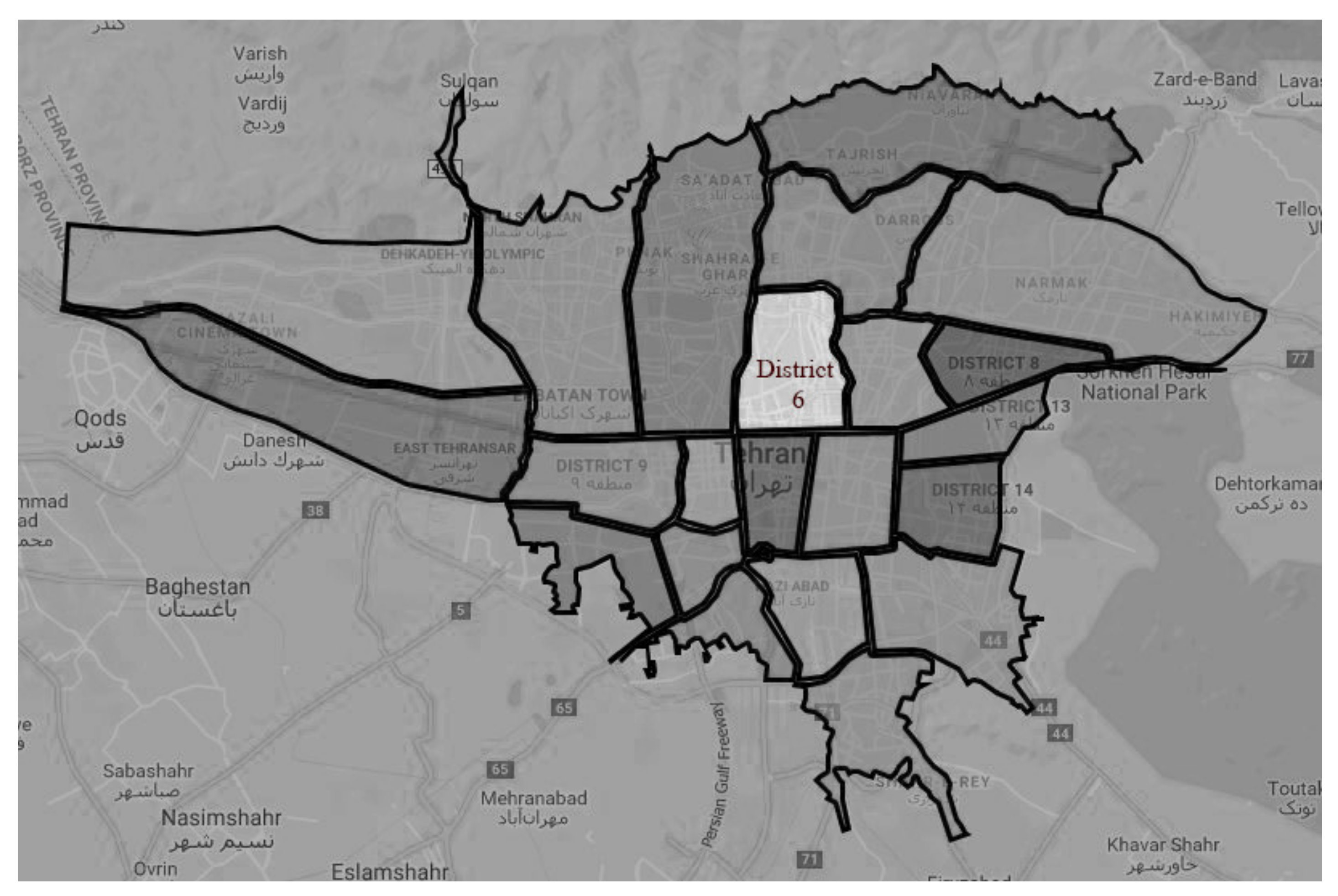

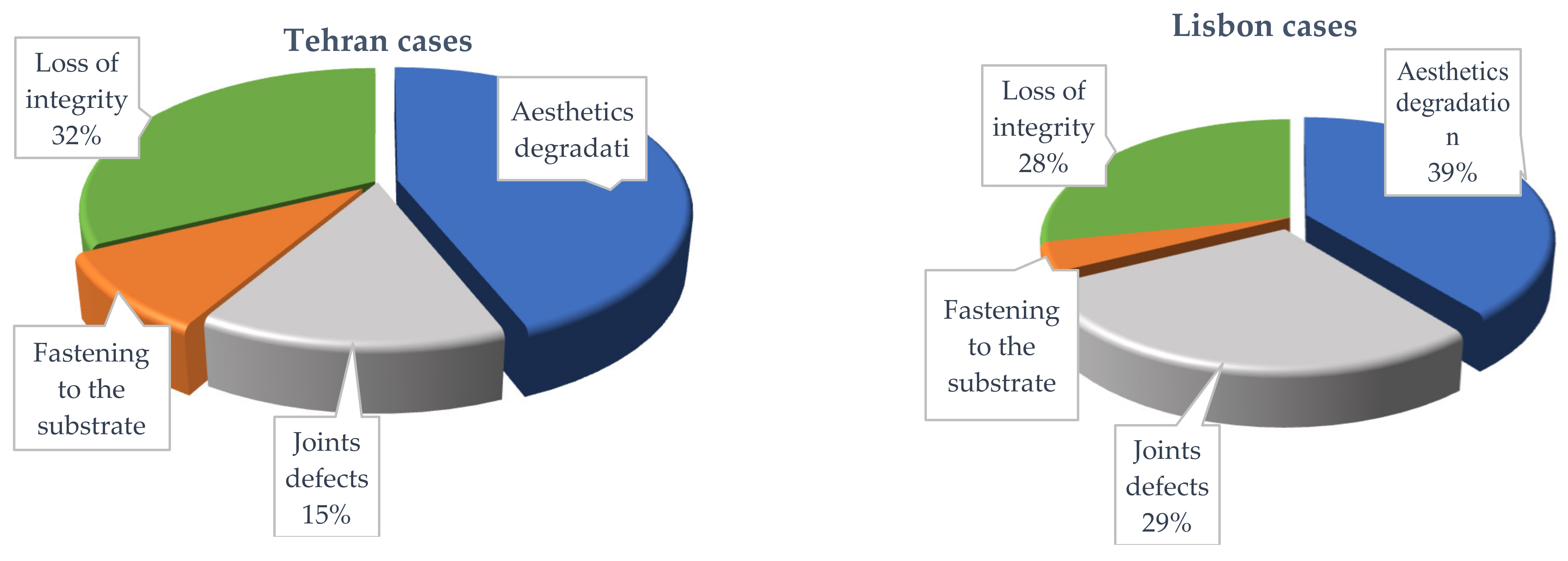
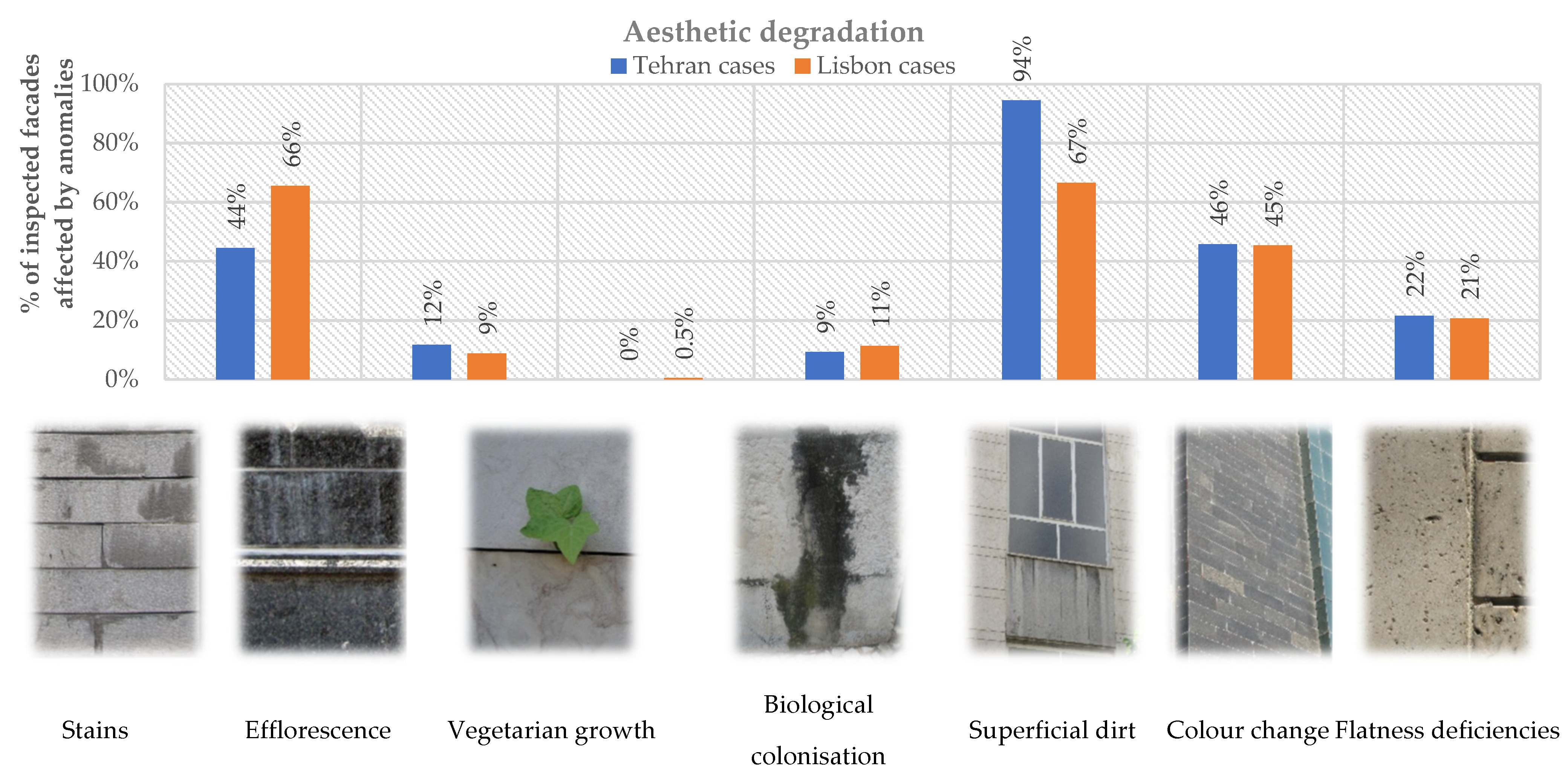
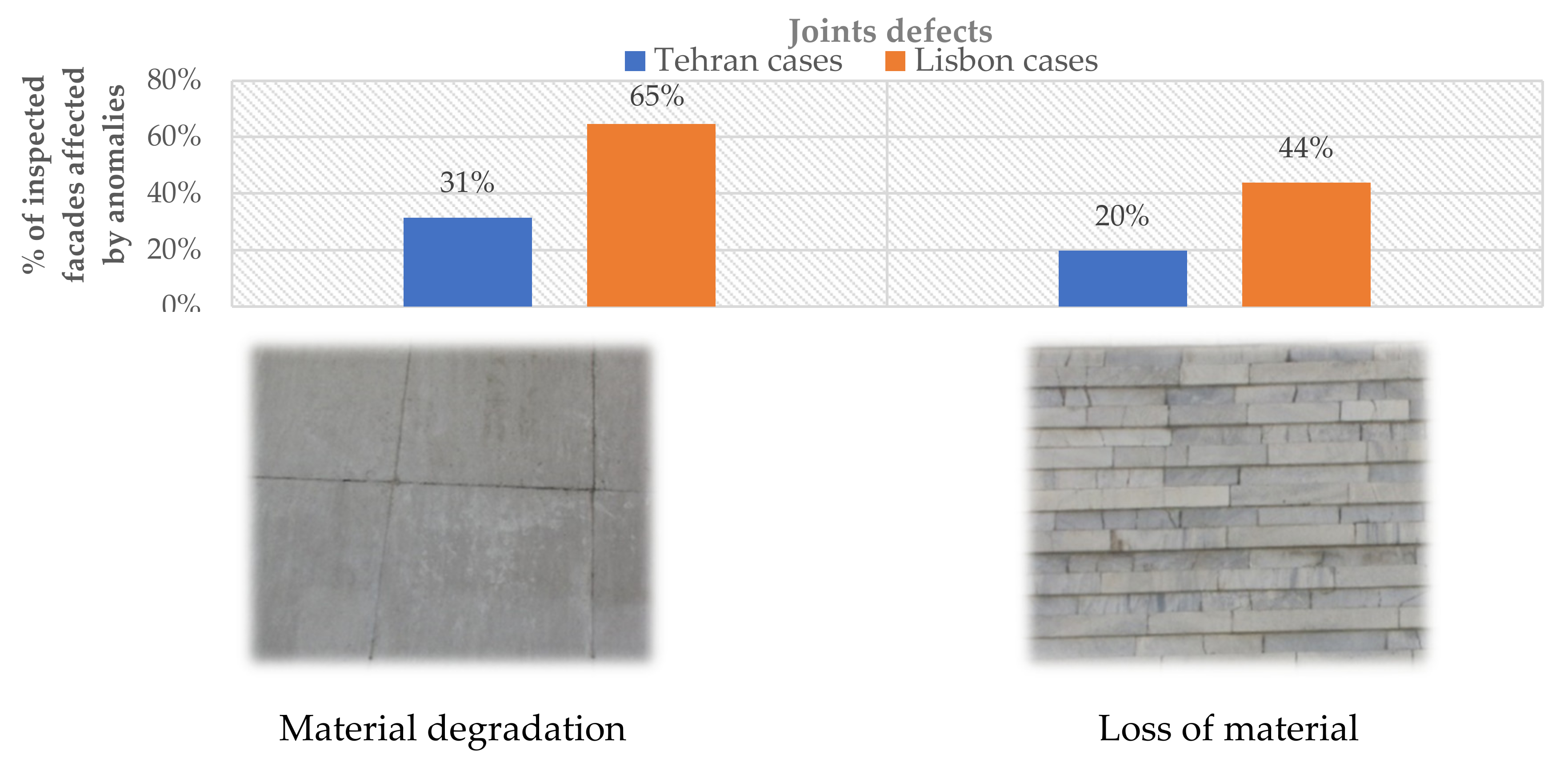



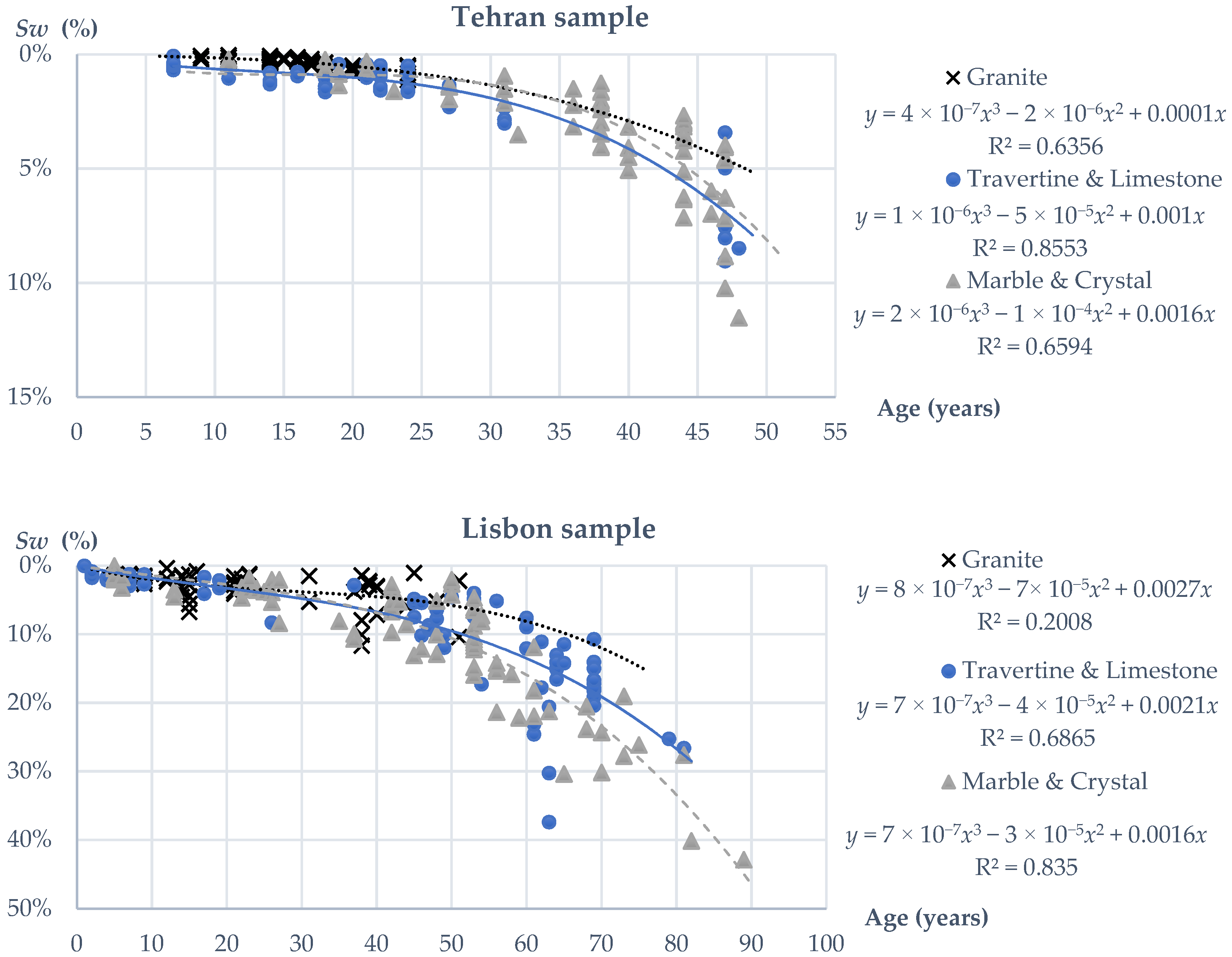
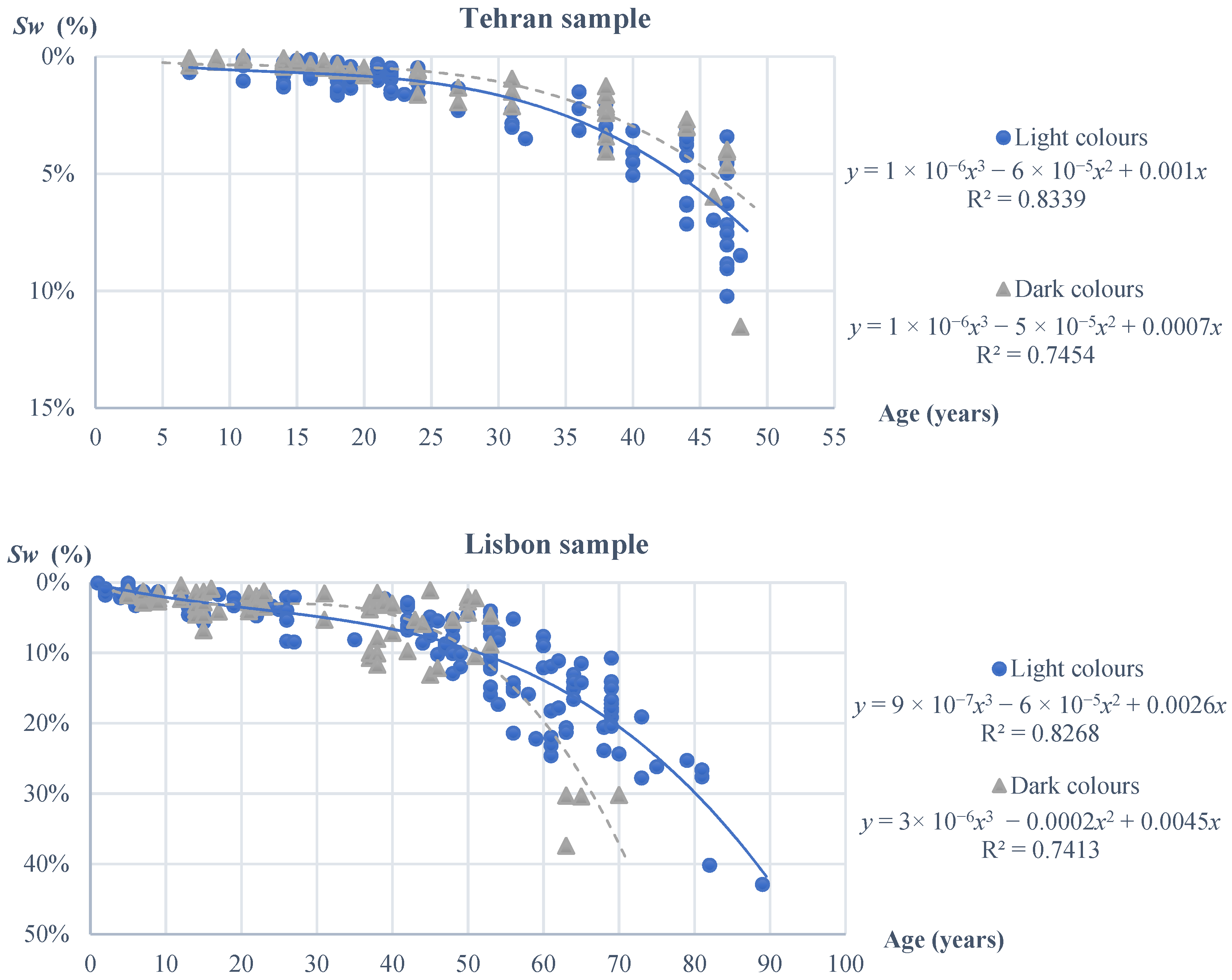
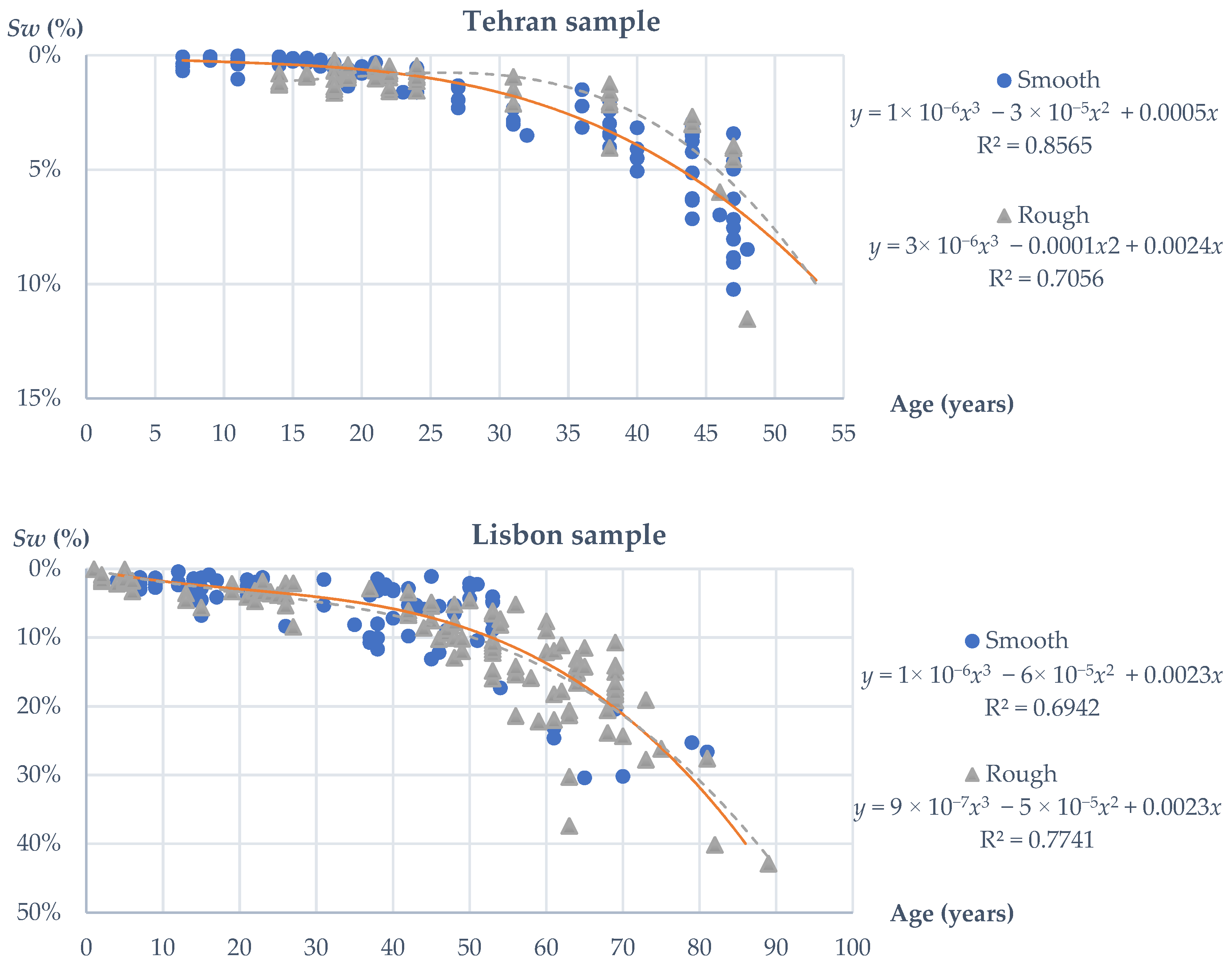

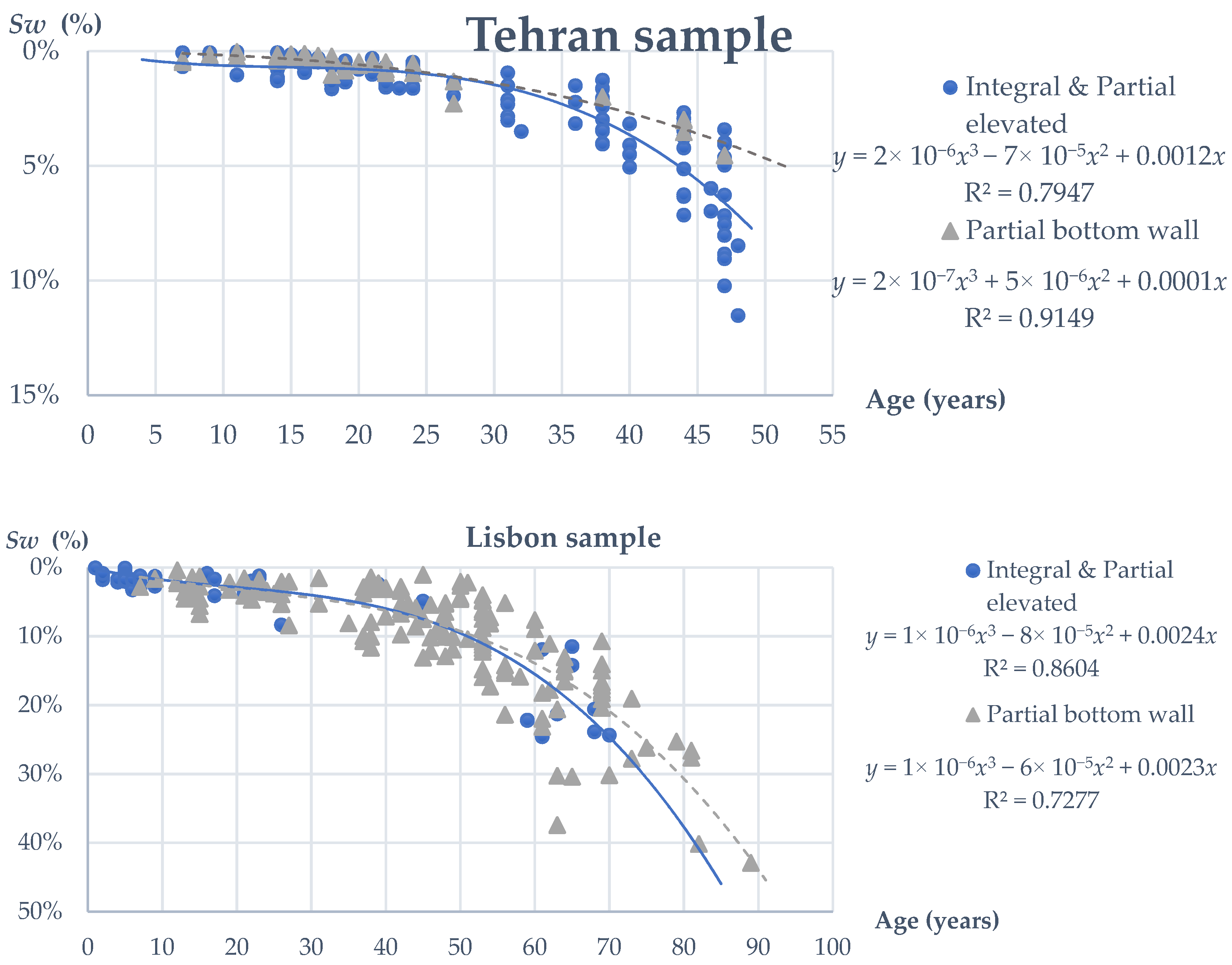

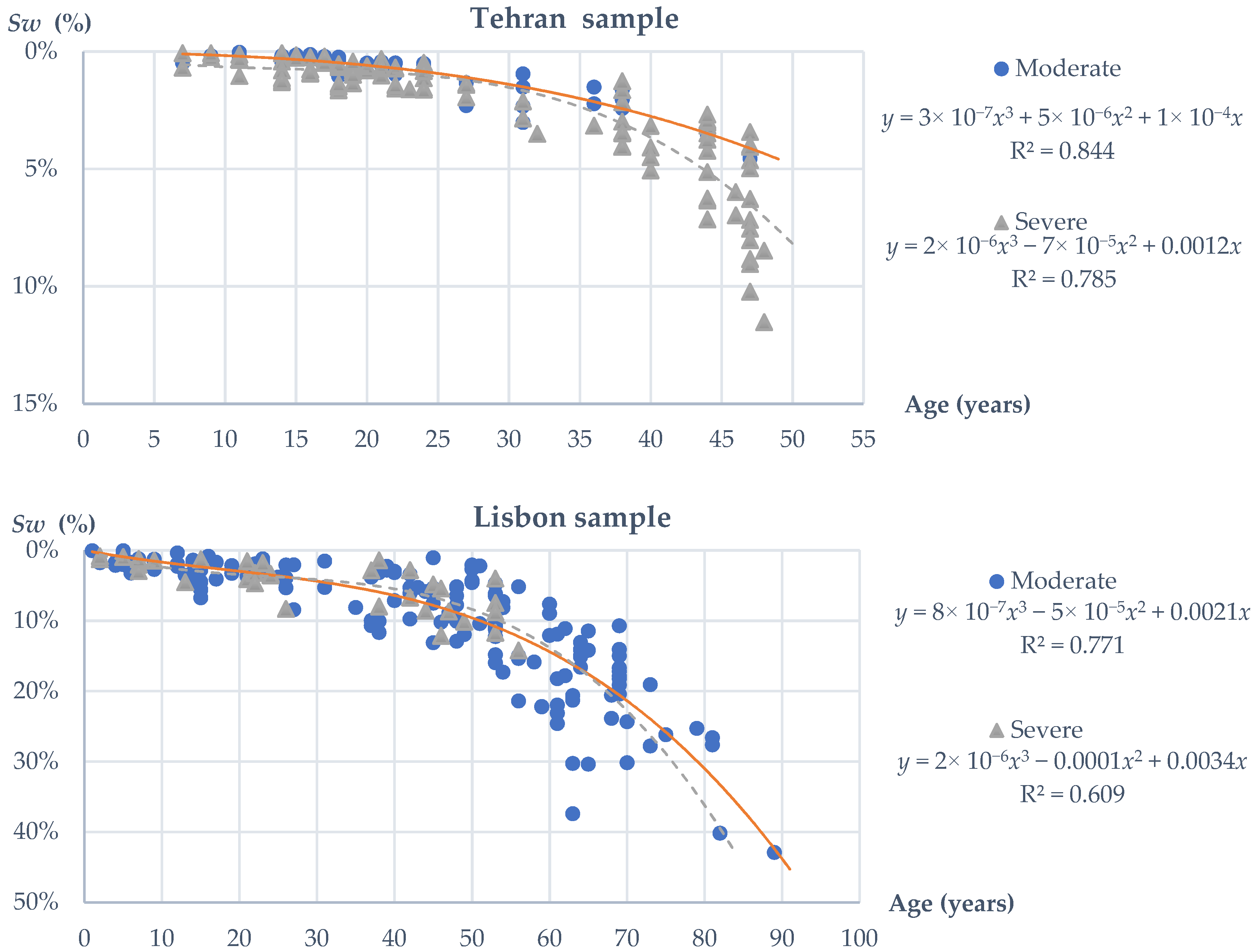
| Cladding Characteristics | Tehran (162 Cases) | Lisbon (203 Cases) | |||
|---|---|---|---|---|---|
| Number of Cases | % of Cases | Number of Cases | % of Cases | ||
| Type of Stone | Granite | 52 | 32.1% | 54 | 26.6% |
| Limestone | 47 | 29.0% | 72 | 35.5% | |
| Marble | 63 | 38.9% | 77 | 37.9% | |
| Colour of natural stone | Light colours | 101 | 62.3% | 134 | 66.0% |
| Dark colours | 61 | 37.7% | 69 | 34.0% | |
| Type of finishing | Smooth | 108 | 66.7% | 96 | 47.3% |
| Rough | 54 | 33.3% | 107 | 52.7% | |
| Size of stone plates | Medium size | 105 | 64.8% | 129 | 63.5% |
| Large size | 57 | 35.2% | 74 | 36.5% | |
| Location of the cladding | Integrally or partially elevated | 116 | 71.6% | 61 | 30.0% |
| Partial bottom | 46 | 28.4% | 142 | 70.0% | |
| Orientation | South/southwest | 20 | 12.3% | 35 | 17.2% |
| East/southeast | 32 | 19.8% | 60 | 29.6% | |
| West/northwest | 32 | 19.8% | 51 | 25.1% | |
| North/northeast | 78 | 48.1% | 57 | 28.1% | |
| Height of the building | Current (≤5 floors) | 122 | 75.3% | 110 | 54.2% |
| High (>5 floors) | 40 | 24.7% | 93 | 45.8% | |
| Use of the building | Residential | 149 | 92.0% | 104 | 51.2% |
| Mixed use | 13 | 8.0% | 99 | 48.8% | |
| Exposure to wind/rain | Moderate | 58 | 35.8% | 170 | 83.7% |
| Severe | 104 | 64.2% | 33 | 16.3% | |
| Degradation Level | Anomaly | % Area of Cladding Affected (**) | |
|---|---|---|---|
| Level 0 | No visible degradation | - | |
| Level 1 Good | Aesthetic degradation anomalies | Surface dirt | >10% |
| Moisture stains | ≤15% | ||
| Localised stains | |||
| Colour change | |||
| Flatness deficiencies | ≤10% | ||
| Loss-of-integrity anomalies | Material degradation (*) ≤ 1% plate thickness | - | |
| Material degradation (*) ≤ 10% plate thickness | ≤20% | ||
| Cracking width ≤ 1 mm | |||
| Level 2 Slight Degradation | Aesthetic degradation anomalies | Moisture stains | >15% |
| Localised stains | |||
| Colour change | |||
| Biological colonisation | ≤30% | ||
| Vegetation growth | |||
| Efflorescence | |||
| Flatness deficiencies | >10% and ≤50% | ||
| Joint anomalies | Joint material degradation | ≤30% | |
| Material loss—open joint | ≤10% | ||
| Fastening to the substrate anomalies | Scaling of stone near the edges | ≤20% | |
| Partial loss of stone material | |||
| Loss-of-integrity anomalies | Material degradation (*) ≤ 10% plate thickness | ≤20% | |
| Material degradation (*) > 10% and ≤ 30% plate thickness | ≤20% | ||
| Cracking width ≤ 1 mm | ≤20% | ||
| Cracking width > 1 mm and ≤ 3 mm | ≤20% | ||
| Fracture | ≤5% | ||
| Level 3 Moderate degradation | Aesthetic degradation anomalies | Biological colonisation | >30% |
| Vegetation growth | |||
| Efflorescence | |||
| Flatness deficiencies | >50% | ||
| Joint anomalies | Joint material degradation | ≤30% | |
| Material loss—open joint | ≤10% | ||
| Fastening to the substrate anomalies | Scaling of stone near the edges | >20% | |
| Partial loss of stone material | |||
| Detachment | ≤10% | ||
| Loss-of-integrity anomalies | Material degradation (*) > 10% e ≤ 30% plate thickness | >20% | |
| Material degradation (*) ≤ 30% plate thickness | ≤20% | ||
| Cracking width > 1 mm and ≤ 3 mm | >20% | ||
| Cracking width ≥ 3 mm | ≤20% | ||
| Fracture | >5% and ≤10% | ||
| Level 4 Generalised degradation | Fastening to the substrate anomalies | Detachment | >10% |
| Loss-of-integrity anomalies | Material degradation (*) > 30% plate thickness | >20% | |
| Cracking width > 3 mm | |||
| Fracture | >10% | ||
| Anomaly | Repair Operation | Weighting Coefficient (ka,n) | |
|---|---|---|---|
| Tehran | Lisbon (*) | ||
| Aesthetic degradation | Cleaning | 0.12 | 0.13 |
| Joints | Joint repair | 0.13 | 0.25 |
| Replacement of the joint materials | 1.00 | 1.00 | |
| Fastening to the Substrate | Replacement of stone plates | 1.23 | 1.20 |
| Loss of Integrity | Repairing the affected stone plates | 1.02 | 1.00 |
| Cladding Characteristics | R2 of the Degradation Curves | Estimated Service Life * (Years) | Service Life Gain or Loss According to the Claddings’ Characteristics ** (%) | ||||
|---|---|---|---|---|---|---|---|
| Tehran | Lisbon | Tehran | Lisbon | Tehran | Lisbon | ||
| Type of stone | Granite | 0.6356 | 0.2008 | 78 | 83 | 20% | 22% |
| Travertine and limestone | 0.8553 | 0.6865 | 64 | 71 | −1% | 4% | |
| Marble and crystal | 0.6594 | 0.8350 | 63 | 66 | −3% | −3% | |
| Colour of natural stone | Light colours | 0.8339 | 0.8268 | 64 | 69 | −1% | 1% |
| Dark colours | 0.7454 | 0.7413 | 67 | 60 | 2% | −12% | |
| Type of finishing | Smooth | 0.8565 | 0.6942 | 66 | 69 | 1% | 1% |
| Rough | 0.7056 | 0.7741 | 62 | 67 | −5% | −1% | |
| Size of stone plates | Medium size | 0.8068 | 0.7729 | 67 | 71 | 3% | 4% |
| Large size | 0.8344 | 0.7482 | 61 | 66 | −5% | −3% | |
| Location of the cladding | Integral | 0.7947 | 0.8604 | 63 | 65 | −3% | −4% |
| Partial bottom | 0.9149 | 0.7277 | 87 | 69 | 34% | 1% | |
| Orientation | South/southwest | 0.6776 | 0.9047 | 74 | 71 | 14% | 4% |
| East/southeast | 0.7351 | 0.7144 | 78 | 70 | 21% | 3% | |
| West/northwest | 0.8630 | 0.8835 | 64 | 64 | −2% | −6% | |
| North/northeast | 0.8413 | 0.5918 | 63 | 67 | −3% | −1% | |
| Wind–rain action | Moderate | 0.8442 | 0.7711 | 85 | 68 | 31% | 0% |
| Severe | 0.7849 | 0.6090 | 64 | 67 | −2% | −1% | |
Publisher’s Note: MDPI stays neutral with regard to jurisdictional claims in published maps and institutional affiliations. |
© 2021 by the authors. Licensee MDPI, Basel, Switzerland. This article is an open access article distributed under the terms and conditions of the Creative Commons Attribution (CC BY) license (https://creativecommons.org/licenses/by/4.0/).
Share and Cite
Mousavi, S.H.; Silva, A.; de Brito, J.; Ekhlassi, A.; Hosseini, S.B. Degradation Assessment of Natural Stone Claddings over Their Service Life: Comparison between Tehran (Iran) and Lisbon (Portugal). Buildings 2021, 11, 438. https://doi.org/10.3390/buildings11100438
Mousavi SH, Silva A, de Brito J, Ekhlassi A, Hosseini SB. Degradation Assessment of Natural Stone Claddings over Their Service Life: Comparison between Tehran (Iran) and Lisbon (Portugal). Buildings. 2021; 11(10):438. https://doi.org/10.3390/buildings11100438
Chicago/Turabian StyleMousavi, S. H., Ana Silva, Jorge de Brito, A. Ekhlassi, and S. B. Hosseini. 2021. "Degradation Assessment of Natural Stone Claddings over Their Service Life: Comparison between Tehran (Iran) and Lisbon (Portugal)" Buildings 11, no. 10: 438. https://doi.org/10.3390/buildings11100438
APA StyleMousavi, S. H., Silva, A., de Brito, J., Ekhlassi, A., & Hosseini, S. B. (2021). Degradation Assessment of Natural Stone Claddings over Their Service Life: Comparison between Tehran (Iran) and Lisbon (Portugal). Buildings, 11(10), 438. https://doi.org/10.3390/buildings11100438








